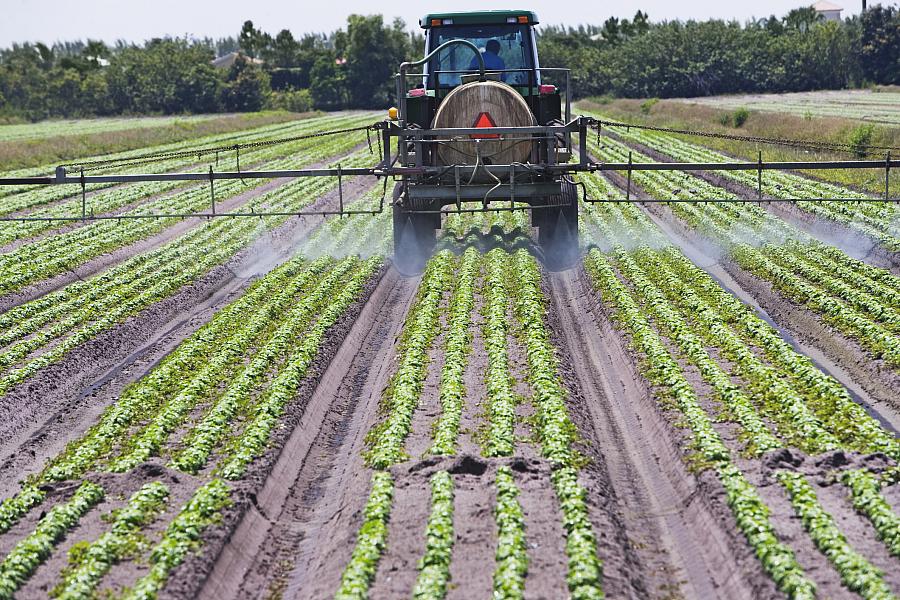We used a novel strategy to make visible the impact of pesticide exposure among farmworkers in the U.S.

(Getty Images)
When we set out to report on pesticide exposure among farmworkers in the U.S., we had a recurring question in mind: How can we show the threats they face in a way that resonates more with our audience at Univision News? We had heard from experts, advocates, and farmworkers about the frequent exposures they endure. But we knew making it more visible would help viewers more fully grasp the impact pesticides have on workers' health.
With the help of scientists and experts, we devised a method that, as far as we know, had never been used on farmworkers as a reporting tool: silicone wristbands that can detect up to 75 types of pesticides.
Our two-year reporting journey took us to Michigan, North Carolina, and Florida, where we had 10 farmworkers wear the wristbands for at least a week. The wristbands detected up to 18 pesticides, some linked to an increased risk of cancer, reproductive problems, and neurological diseases, among other possible health impacts.
While the wristbands can’t determine if any chemicals entered the farmworkers’ bodies, they provided a substantive snapshot of the pesticides commonly present in agricultural areas where workers spend their days, or even live. The findings were consistent with other research showing that “all agricultural workers are exposed to a wide range of pesticides consistently across the agricultural seasons,” as a medical anthropologist who helped analyze the results told us.
Along the way, we uncovered harrowing stories linked to pesticide exposure, which we incorporated into our project. Among them are José, who suffered second-degree skin burns from a highly toxic pesticide; Marta, who developed cancer after years of applying chemicals; and Carlos, a young man born without limbs after his pregnant mother was repeatedly exposed while picking tomatoes in Florida and North Carolina.
Our story — “Exposed: Latino farmworkers risk their health working under the threat of pesticide exposure” — was published in both English and Spanish. The multimedia presentation includes text, photos, and scrollytelling that present the wristband exposure results in a dynamic, easy-to-grasp way.
The scrollytelling meticulously walks viewers through the science while humanizing the individuals behind the data. We felt their stories had to be at the forefront of our investigation. That’s why we created illustrations representing each farmworker, including information about their country of origin, the types of crops they worked with while wearing the wristbands, and how many years they’ve been working on U.S. farms.
In addition to the multimedia presentation, we produced two short documentaries: “Exposed: How pesticides harm farmworkers,” and “Born without arms or legs: How Carlos Candelario lives with the consequences of pesticide exposure.”
The second documentary tells the story of Carlos Candelario, a case frequently mentioned by advocates in Florida. Born on December 17, 2004, with tetra-amelia syndrome, characterized by the absence of all four limbs, his mother, Francisca Herrera, had been exposed to chemical cocktails while working in tomato fields. At the time, she was unaware she was in her first trimester of pregnancy.
Nearly 20 years later, we wondered about Candelario’s life. Andy Yaffa, the lawyer who represented him and his family, contacted his mother, who was hesitant to speak after so much suffering. A year later, we asked Yaffa to call them again and put us on the line to explain our project in more detail. Much to our surprise, Francisca said that after initially declining, her son asked why he wasn’t consulted. She decided to wait and see if we’d reach out again. Carlos wanted to share his story for the first time.
Reporting these stories with empathy and sensitivity was a priority. With the help of community organizations, we took extra precautions when meeting with farmworkers. We were careful not to give out details that would make them identifiable, such as precise locations of their work and their names. The drawings in our multimedia presentation are illustrative only, and do not include physical traits that could reveal farmworkers' identities.
We also ensured those who gave testimonies understood the possible repercussions of showing their faces. In some cases, we found ways to film them while protecting their anonymity. We made it clear from the start that they were in control of what they wanted to share, and even omitted compromising information they didn’t explicitly ask us to leave out.
Our team of three is now organizing events with farmworker communities to engage with them and present our reporting. We’re proud that our project has successfully amplified the stories of those most affected by pesticide exposure. Hopefully, we’ve increased the sense of urgency to protect them.


